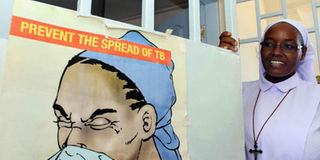TB infections increase as govt strategizes to fight disease

Sister Veronicah Wanjiru displays a message at Mbungoni Catholic Clinic in Mombasa agitating for the eradication of TB. New infections are still increasing. PHOTO | JOSEPH KANYI | NATION MEDIA GROUP
What you need to know:
- The highest tuberculosis infections were reported among men aged 25 to 34 followed by women over 65 years old.
- Tuberculosis is the fifth leading cause of death in Kenya after pneumonia, malaria, cancer and HIV.
The number of Kenyans with tuberculosis has doubled since 2015 with more men than women being affected, a survey has shown.
The report shows there are 558 people with tuberculosis out of every 100,000, up from 233 cases for 100,000 in 2015.
The highest tuberculosis infections were reported among men aged 25 to 34 followed by women over 65 years old.
According to a national survey on tuberculosis carried out last year and released on Friday to mark the World TB Day, those with symptoms, especially men, do not seek medical help and many of those who shun treatment do so because they do not think it is serious.
The report notes that there are at least 138,105 new infections every year with more infections occurring in urban than rural areas.
Sadly, not all cases are diagnosed. According to the survey, four in 10 Kenyans are undetected and untreated.
The current practice of screening for the disease is done by checking for symptoms such as a cough of more than two weeks, fever, night sweats and weight loss.
But some of these symptoms are not always present and hence some tuberculosis cases are missed, the survey says.
One in four of those found to be infected did not report any symptoms and the danger is that an undiagnosed and untreated individual can infect 10 to 15 people, including children.
KILLER DISEASE
Tuberculosis is the fifth leading cause of death in Kenya after pneumonia, malaria, cancer and HIV.
“These findings will be used in planning and policy formulation to end tuberculosis,” said Dr Enos Masini, the head of the tuberculosis department in the Health ministry.
The ministry recommended the use of chest X-rays to pick up the positive cases as well as checking and testing a patient’s sputum for the disease.
Another reliable and efficient test, GeneXpert, detected 78 per cent of cases, and can also detect the drug-resistant strain, said the ministry.
The survey shows 83 per cent of people with tuberculosis were HIV negative, dispelling the myth that infected patients also have the virus.
The survey concludes that controlling tuberculosis among people with HIV has been successful. It was started in 2015 to reach 500,000 people.
One in three Kenyans, says the report, has the tuberculosis bacteria but is neither ill nor do they show symptoms of the disease.
This translates to about 14.4 million Kenyans who have latent tuberculosis infection, which is not contagious.
However, there is a risk that it can turn into active tuberculosis due to poverty, malnutrition, poor housing and sanitation, HIV, tobacco and alcohol use and diabetes, shows the report.
Experts say the tuberculosis causing bacterium, mycobacterium tuberculosis, is also becoming increasingly resistant to antibiotics used to treat it.
This leads to multi-drug resistant tuberculosis. About 1,400 cases of this strain have been reported in Kenya and 480,000 globally.
The strain is more expensive to treat and also takes about two years, which includes six months of daily injections compared to normal tuberculosis, which can be cured in six months.
Kenya spends nearly Sh11 billion annually in hospitalisation costs, absenteeism from work, death and out of pocket expenditures for care.
The World TB Day commemorates the day, in 1882, when Dr Robert Koch announced that he had discovered the cause of the disease.





